Security for Microsoft Internet Explorer
I Why protect your browser II Learn browser features III
Vulnerabilities and attacks
- ActiveX controls
- Java
- Cross-Site Scripting
- Cross-Zone and Cross-Domain vulnerabilities
- Threats from Script scripts, Active and HTML components
- Fake spoofing (Spoofing)
IV
Make planes to protect your browser
- Microsoft Windows Internet Explorer
- Mozilla Firefox
- Apple Safari browser
- Other browsers
V Keep your computer safe
IV, Make planes to protect your browser
Some software features that provide functionality for a browser such as ActiveX, Java, and Scripting (JavaScript, VBScript .) can also cause vulnerabilities to computer systems. They can arise from the poor of protocols, designs and software that are written or configured insecure. For many reasons, you should understand which browser supports what features and what risks can happen to them. Many browsers allow you to disable these technologies while others can only allow you to reduce their functionality.
In this section, we will show you how to safely configure the most popular browsers and how to disable the features that might cause the vulnerability mentioned above. If a company doesn't provide documentation for how you can protect the browser, we recommend that you contact them and ask them about it.
Browsers are regularly upgraded. Depending on the version of the software, features and options may vary.
A, Microsoft Internet Explorer
Microsoft Internet Explorer is a browser built into the Microsoft Windows operating system. Therefore, removing this application is completely unrealistic.
In addition, the browser supports Java, script execution scripts and other forms of active components and Internet Explorer also add ActiveX technology. When any application has a potential vulnerability, it is possible to significantly reduce the number of dangerous vulnerabilities by using a browser that does not support ActiveX controls. However, using a number of alternate browsers may affect the functionality of some pages that require ActiveX controls. Note that using another browser will not remove Internet Explorer or other components from the system. Other software such as the user's email browsing software may involve Internet Explorer, browser ActiveX controls or MSHTML. Using these products may be as risky as described above. The 2000 CERT / CC ActiveX conference results can be found at http://www.cert.org/reports/activeX_report.pdf for further research.
Here are some steps to disable features in Internet Explorer. Note that the options menu may vary for different versions of Internet Explorer, so you should adjust the steps below accordingly.
To change settings for Internet Explorer, select Tools then Internet Explorer .
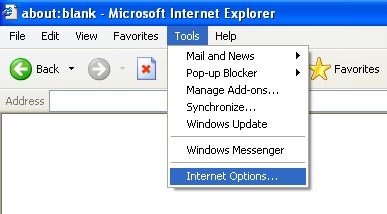
Select the Security tab. On this tab you will find in the above section a list of different security areas that Internet Explorer uses. You can go to Setting Up Security Zones address to get more information about security zone. For each region, you can choose an optional level of protection. Click the Custom Level button and you will see the second window opened and allow you to select the protection settings for those areas. The Internet zone is where all web sites start to be approved. The security settings for this zone are applied to all pages not listed in another security zone. We recommend using the High level for this area. With High select, some features including ActiveX , Active scripting and Java will be disabled. With the features disabled, your browser will be more secure. Click the Default Level button and then drag the control bar to High .
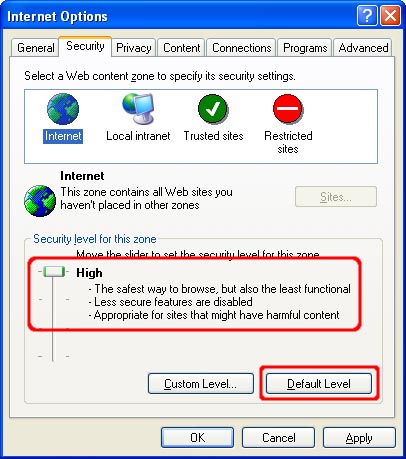
To adjust the features in each zone, click the Custom Level button. Here you can control specific security options that apply to that area. The default values for high security settings can be selected by selecting High and clicking the Reset button to accept the change.
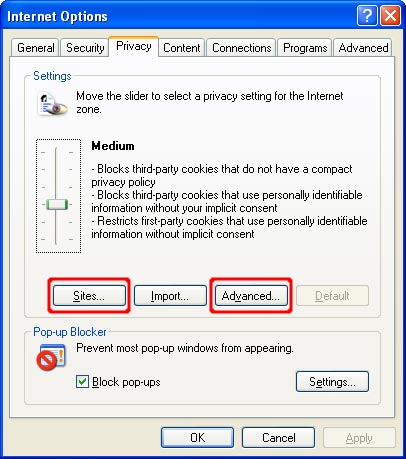
Trusted sites are a secure area for websites you trust that have been designed to be safe and reliable. To add or remove pages from this zone, you can click the Sites button . This will help you open a new window and will list you with a list of sites that you trust and allow you to add or remove pages here. You can also request that only these pages be added with Secure Sockets Layer (SSL) that can be enabled in this zone. This allows you to verify that the page you are visiting is a secure site.
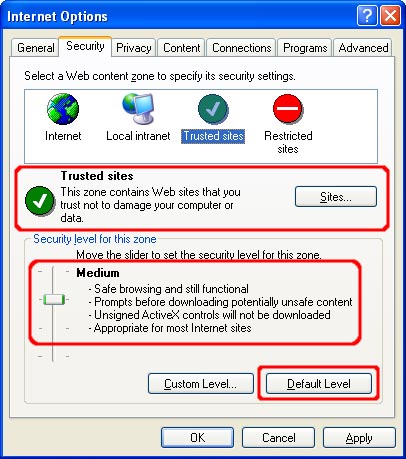
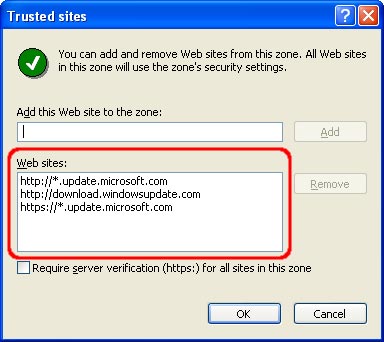
We recommend setting security levels for Trusted sites in Medium mode. When Internet Zone is set to a high level, you may encounter problems that pages do not have enough of their functions due to one or more related security settings. This is where Trusted sites can help you. If you believe that the site will not contain malicious code, you can add it to the list of sites in the Trusted sites area. When a page is added, features like ActiveX and active scripting will be activated. The benefit of this type of configuration is that Internet Explorer will be more secure and pages can be 'whitelisted' in the Trusted sites to increase functionality.
The Privacy tab includes settings for cookies. Cookies are text files placed on your computer for different pages that you visit them directly or indirectly through, for example, banner ads. A Cookie may contain any data that a site saves it for its own purposes. It is often used to check your computer when you move through a website and save information like hobby. We recommend that you select the Advanced button and select Override automatic cookie handling . Then select Prompt for both first and third group cookies. This will remind you every time a website tries to place a cookie on your computer. You can then evaluate the original page, want to accept or restrict cookies and what actions to take in the future (always accept, always lock or continue to ask).
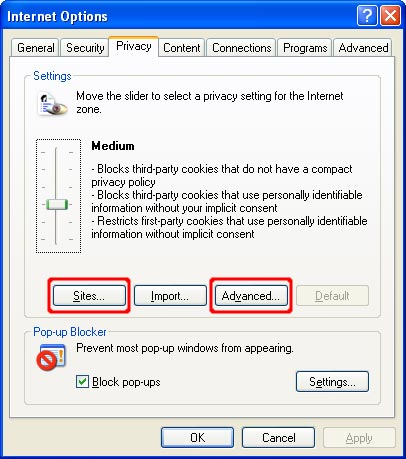
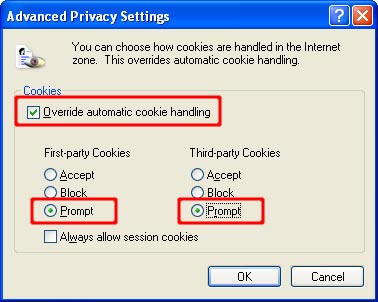
By selecting the Sites button . , you can manage cookie settings for specific pages. You can add or remove pages, you can change the current settings for existing pages. The bottom of this window will indicate the area of the page and the action needed when the page wants to place a cookie on your computer. You can use the upper part of the window to change the settings.
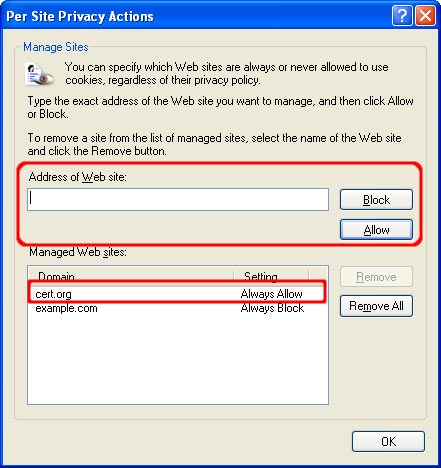
The Advanced tab contains settings used for all regions. The settings included in the Multimedia section have features that you can adjust to protect against other potential vulnerabilities. For example, attackers can check your computer usage habits or exploit the software you use to play multimedia data. We recommend disabling the option to listen to music and watch videos.
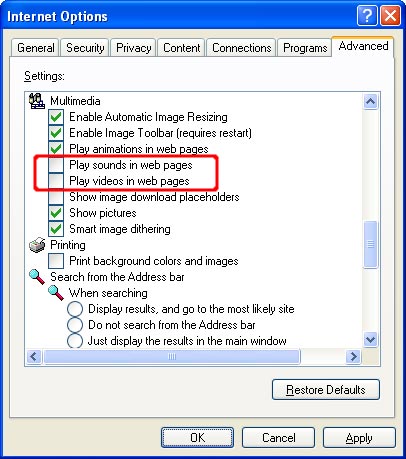
Under the Programs tab, you can specify applications that are viewed in websites, e-mail, and other network-related tasks. You can also protect Internet Explorer from showing you a message asking about your default web browser.
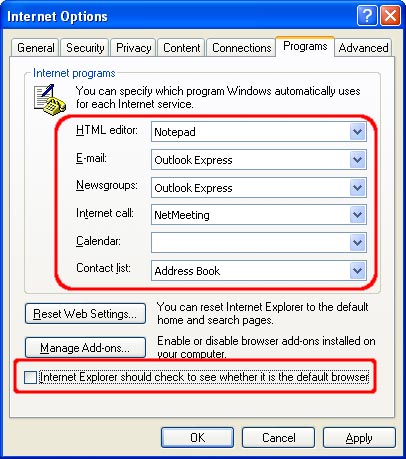
If you do not use Internet Explorer, you can continue to watch the following sections. See the following article: Secure Mozilla Firefox .
You should read it
- Ways to uninstall Internet Explorer 8 on Windows XP / Vista / 7
- How to remove Internet Explorer 10 in Windows 8
- After 11 years, Internet Explorer 6 is still 'king'
- How to Update Microsoft Internet Explorer
- The 7 most common problems in Internet Explorer
- Internet Explorer 11 users increase rapidly
- Internet Explorer is the most popular user
- IE 8 running on Windows XP is supported until 2016
May be interested
- Microsoft 'killed' Internet Explorer from June 15, 2022
 on may 20, the leading us technology company microsoft officially announced its plan to permanently close internet explorer (ie) browser after more than 25 years.
on may 20, the leading us technology company microsoft officially announced its plan to permanently close internet explorer (ie) browser after more than 25 years. - Looking back at the 'life' full of ups and downs of Internet Explorer
 after nearly 27 years, microsoft has finally killed internet explorer. although it used to be microsoft's iconic browser, ie has had a long and bumpy road.
after nearly 27 years, microsoft has finally killed internet explorer. although it used to be microsoft's iconic browser, ie has had a long and bumpy road. - How to enable Internet Explorer mode on Microsoft Edge
 although the internet explorer browser has been discontinued, there are still some old websites that are not suitable for modern browsers, so users cannot open and read content.
although the internet explorer browser has been discontinued, there are still some old websites that are not suitable for modern browsers, so users cannot open and read content. - Microsoft provides February patch to terminate 22 errors
 yesterday, microsoft released 12 security updates and 22 bugs in windows, internet explorer (ie), office and its internet server software.
yesterday, microsoft released 12 security updates and 22 bugs in windows, internet explorer (ie), office and its internet server software. - Microsoft urges Windows users to upgrade to Internet Explorer 11 browser
 microsoft has decided to create an opportunity for users to upgrade to ie11 when releasing an update of this operating system version via windows update.
microsoft has decided to create an opportunity for users to upgrade to ie11 when releasing an update of this operating system version via windows update. - How to Uninstall Internet Explorer 11 on Windows 7
 internet explorer 11 is the latest version of microsoft's web browser, but not everyone likes to use it. if you prefer to use an older version, or internet explorer 11 doesn't work well, you can return to the original version by uninstalling internet explorer updates. you can do it on windows or with command prompt.
internet explorer 11 is the latest version of microsoft's web browser, but not everyone likes to use it. if you prefer to use an older version, or internet explorer 11 doesn't work well, you can return to the original version by uninstalling internet explorer updates. you can do it on windows or with command prompt. - Microsoft released the first build of Windows 10 without Internet Explorer
 microsoft has just released the first build of windows 10 without the familiar name internet explorer for windows insider users in the dev channel, marking the necessary end of a 'ghost' that has existed and haunts people. used windows for many years.
microsoft has just released the first build of windows 10 without the familiar name internet explorer for windows insider users in the dev channel, marking the necessary end of a 'ghost' that has existed and haunts people. used windows for many years. - The 7 most common problems in Internet Explorer
 sometimes you may find yourself in situations where you must use internet explorer. let's take a look at quick fixes for common internet explorer issues so you don't have trouble experimenting with this old browser.
sometimes you may find yourself in situations where you must use internet explorer. let's take a look at quick fixes for common internet explorer issues so you don't have trouble experimenting with this old browser. - Ways to uninstall Internet Explorer 8 on Windows XP / Vista / 7
 internet explorer 8 has many new and useful features. however, in some cases, upgrading to internet explorer 8 can still cause problems. to resolve these problems, you can uninstall internet explorer 8 from the operating system.
internet explorer 8 has many new and useful features. however, in some cases, upgrading to internet explorer 8 can still cause problems. to resolve these problems, you can uninstall internet explorer 8 from the operating system. - Internet Explorer has vulnerabilities, unused users are still hacked
 recently, security researcher john page has discovered a new security vulnerability in this outdated web browser that allows hackers to steal user data.
recently, security researcher john page has discovered a new security vulnerability in this outdated web browser that allows hackers to steal user data.
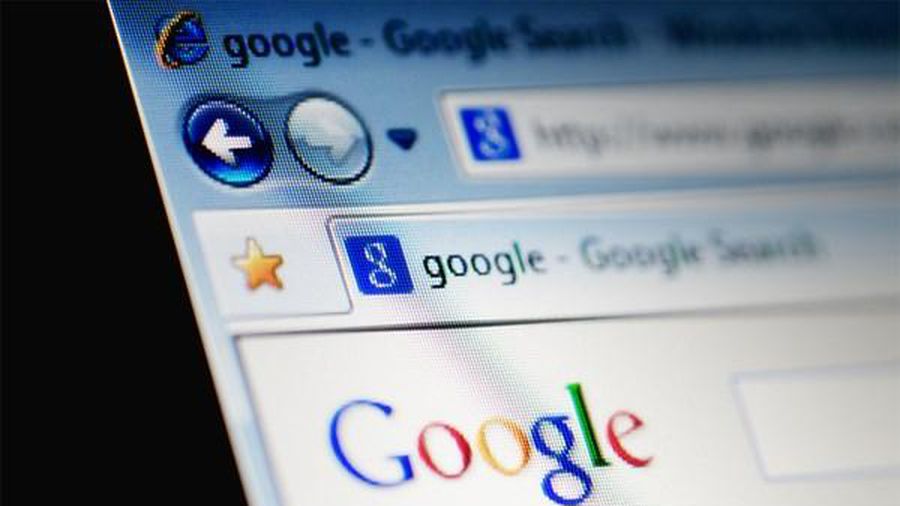









 Type Vietnamese in Internet Explorer when using Windows Vista
Type Vietnamese in Internet Explorer when using Windows Vista Shortcuts in Vista
Shortcuts in Vista Something to know about AutoComplete
Something to know about AutoComplete Fix bug that could not download files on Internet Explorer
Fix bug that could not download files on Internet Explorer Windows 7 allows users to delete IE8
Windows 7 allows users to delete IE8 Choose the best browser for netbooks
Choose the best browser for netbooks